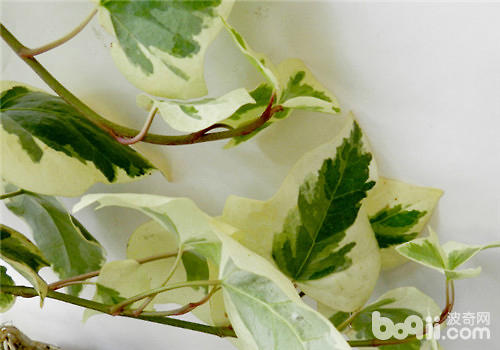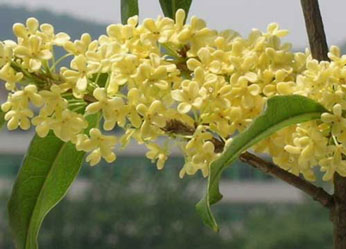Key points of propagation and cultivation of Ivy
Ivy, also known as foreign ivy, spring rattan, English ivy, is an evergreen woody vine belonging to the genus Ivy of Araliaceae. Climbing or creeping, up to 30 m long. It has aerial root climbing ability, but the adsorption ability of aerial root varies with varieties and environmental conditions. Leaves vary in size and shape, often 3-5-lobed on vegetative branches, entire or subentire; leaves on reproductive branches unlobed, narrowly ovate or subrhombic. Umbels globose, flowers white. Fruit globose, black at maturity.
Likes warm, moist and semi-shady environment and fertile, moist and well-drained soil. Drought tolerance is poor, not resistant to direct sunlight, but very resistant to shade, frost and dry climate. North can only potted, greenhouse winter.
Propagation can be used cutting or layering method, spring and autumn for seedling appropriate period, cut stem top or stem section, each section 3~4, cutting in river sand or humus loam, maintain humidity, accept sunshine about 50%~70%, about 1 month can root into seedlings. Another stem tendrils cut wound, buried in the culture soil, to be vigorous growth of roots, and then cut off into new plants, this method is layering method.
Ivy soil requirements are not strict, cultivation to humus loam is better. But for potted plants, pot soil can be mixed by garden soil, 1/4 of plant ash and a small amount of base fertilizer. Plant ash is selected to keep the pot soil loose and breathable, and more potassium fertilizer can be used to meet the needs of ivy growth. Ivy in the growing season can be applied once every two weeks liquid fertilizer, or once a month granular fertilizer. For mosaic varieties, the proportion of nitrogen fertilizer should not be too high, lest the mosaic turn green. Green leaf ivy can grow under strong light and shade conditions; floral ivy cannot be exposed to sunlight for a long time in summer and autumn. Ivy in the spring when a large number of branches and leaves germinate, regardless of its flowers and leaves are placed in the sun, receive sufficient light, so that the branches and leaves will grow luxuriant, robust.
For column potted plants to often prune, pick the heart. Ivy should be most careful in plum rains and high summer temperatures. Plum season placed outdoors ivy, basin a ponding should be poured out in time, so as not to root for a long time by stains, rot. In summer high temperature season, it is best to choose early morning or evening watering, so as to avoid the difference between soil temperature and water temperature, causing the root system to be injured by reverse, and eventually leading to plant wither and death. Ivy in the case of high temperature or poor ventilation mites or aphids appear, generally available soapy water wash or spray 40% omethoate 1000~ 1500 times liquid can be.
Cultivation Management of Ivy
Ivy cultivation management will introduce ivy cultivation methods, ivy should be how to raise, ivy cultivation problems and solutions
(1)overview
Also known as ivy, araliaceae perennial evergreen vines. Stems 3 - 5 m or more long, much branched. Young branches, petioles and leaves have stellate hairs, branches are easy to take root. Vegetative branch leaves 3-lobed, reproductive branches and leaves rhombic, entire margin. This plant has strong adaptability to the environment, strong shade tolerance and cold tolerance, and is easy to cultivate. In recent years, some cold-resistant varieties introduced from North America in Beijing area have achieved good results in open-air trials and are now being popularized. As an indoor potted leaf viewing coffin, ivy can be grown in a bright room for a long time. In the dark room, as long as the light can be supplemented, it can also grow well. The plant can be placed as a pendent plant on a flower stand, bookcase top or hanging in front of a window; it can also be placed in a small potted plant on a desk, tea, etc.; it can also be erected as a totem pole; and it can be grafted into a small arbory-shaped ivy by using bear paw wood as a rootstock. There are many horticultural varieties of ivy.
(2)cultivation points
Temperature: like cold but afraid of frost, in the indoor conditions without heating can also grow. In the northern part of the country, when it is hot in summer, it grows poorly and should be placed in a cool and ventilated place.
Light: Avoid direct sunlight in summer, do not need shade in winter, and the light can be stronger.
Moisture: keep the basin soil moist during the growth period, avoid basin soil water, reduce irrigation water in winter, and avoid basin soil being too dry.
Air humidity: in high temperature and dry season or indoor, should often spray water to the foliage and around the plant, and often clean the foliage.
Change pots once a year.
Propagation: Cuttings with stems are easy to root.
(3)a common fault in cultivation.
Leaf edge yellow, stem tip bald without leaves: temperature is too high, light is too weak, there may also be red spiders. Cut off this branch.
All leaves turn green: the leaves of mosaic varieties turn green and the patterns disappear; the light is too weak and the sun is too low; in addition, too much nitrogen is also one of the reasons.
Old stem leaves shed light, stem bare: too little light; stem too old, basal leaves shed. Cut off the old branches.
Dry tips, stunted growth: air humidity too low. Watch for red spiders, cut dry branches, increase spray frequency.
Cultivation and Maintenance of Ivy
1. Introduction to Ivy
Ivy originated in China, distributed in the provinces south of Qinling Mountains, is not only one of the main vertical greening trees, but also an excellent woody ground cover plant, but also potted.
Ivy tendrils dense leaves, is a very beautiful evergreen vine flowers, is one of the main vertical greening trees in China's gardens, but also an excellent woody ground cover plants.
Ivy is suitable for planting in buildings, walls, steep slopes, rock walls and the ground under trees, etc., can also be potted. Qi purple vines or climbing on walls, scaffolding, or crawling on the ground, or hanging outside the basin, are elegant. Old leaves, new leaves and primary leaves are interlaced, and the color rhyme is harmonious. Ivy flowers after the bright red cones decorated on the vine, Yang green pan-purple, gorgeous eye-catching, if the small ones made of bonsai, placed on the indoor tea table, flower rack or desk, then the four seasons can be full of spring.
2. Ecological habits
Ivy is an evergreen climbing vine belonging to the genus ivy of araliaceae. Stems with aerial roots. Young branches scaly pilose. Leaves leathery, dark green, long stalked, triangular-ovate on vegetative branches, entire or 3-lobed, ovate to rhombic on flowering branches. Umbels solitary and aggregated into racemes. Flowers are small. Light green white, slightly fragrant. Drupe globose, orange-yellow. The flowering period is from September to November, and the fruiting period is from April to May of the following year.
Ivy is extremely shade-tolerant and can grow in full sunlight. It can withstand low temperatures of-7℃ for a short time. The soil and moisture requirements are not strict, but like warm, moist, loose, fertile soil.
3, cultivation points
Ivy transplantation should be carried out in early autumn or late spring.
After planting, it needs to be pruned to promote branching.
Potted plants, can bind all kinds of home governance, traction shaping.
In order to promote its vine strong leaves luxuriant, should timely appropriate amount of nitrogen, phosphorus, potassium thin fertilizer.
4. Reproduction
Ivy can be used seeding, cuttage, layering and other methods of propagation, of which seeding and cuttage methods are the most commonly used.
(1) Sowing
Mix decaying leaf soil, garden soil and river sand in the ratio of 3:2:2, sift and disinfect the fine ones; you can also use only disinfected fine river sand. After sowing, cover with soil particles twice the diameter of seeds, cover with plastic film or glass sheet, keep moist and bed temperature at 20~25℃, remove film or glass sheet after germination, transplant when seedlings grow to 1~3 leaves.
(2) Cutting
Take the young shoots or older branches of the current year, insert them into the disinfected fine river sand from May to October, keep the soil moist, cover them with plastic film, control the temperature at 20~26℃, control the relative humidity at 80%~90%, root about 20 days, and the survival rate can reach more than 90%.
- Prev

How to conserve ivy
Flower and leaf ivy is a cultivated variety of ivy. This new variety of variegated leaves prefers a humid and semi-overcast environment. The requirement of fertilizer is not high, and it can grow well even if it is not fertilized for a long time. However, if it is fertilized too much, it will grow rapidly and flourish, and the elegant flowers and leaves will disappear and show the common wild green leaves.
- Next

Can you trim the cuttings if the incense grows too high?
Jiuli incense is too tall to fit indoors. Can it be cut? Can the pruned branches be propagated by cutting? The habit of Jiuli incense is to like warmth, sun and cold. Before "the Beginning of Winter", it is necessary to do a good job of anti-freezing and keeping warm. The plant is too tall and can be pruned. But the branches pruned in winter
Related
- Fuxing push coffee new agricultural production and marketing class: lack of small-scale processing plants
- Jujube rice field leisure farm deep ploughing Yilan for five years to create a space for organic food and play
- Nongyu Farm-A trial of organic papaya for brave women with advanced technology
- Four points for attention in the prevention and control of diseases and insect pests of edible fungi
- How to add nutrient solution to Edible Fungi
- Is there any good way to control edible fungus mites?
- Open Inoculation Technology of Edible Fungi
- Is there any clever way to use fertilizer for edible fungus in winter?
- What agents are used to kill the pathogens of edible fungi in the mushroom shed?
- Rapid drying of Edible Fungi

